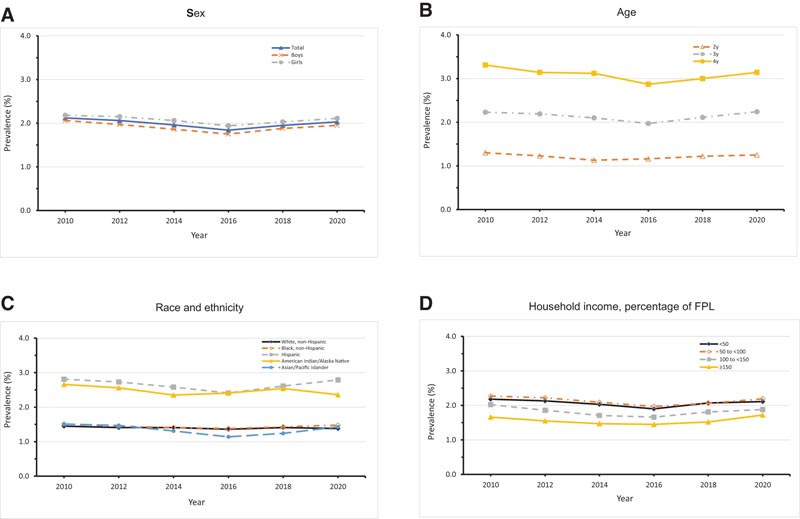Key takeaways
|
Trends in severe obesity among children ages 2 to 4 on WIC: 2010 to 2020
Goals:
To examine the prevalence and trends of severe obesity among 16.6 million children ages 2 to 4 years enrolled in the Special Supplemental Nutrition Program for Women, Infants, and Children (WIC) from 2010 to 2020.
Methods
Severe obesity was defined as a sex-specific BMI for age ≥120% of the 95th percentile on the Centers for Disease Control and Prevention growth charts or a BMI ≥35 kg/m 2
Results
The prevalence of severe obesity decreased significantly from 2.1% in 2010 to 1.8% in 2016 and then increased to 2.0% in 2020. From 2010 to 2016, the prevalence decreased significantly among all sociodemographic subgroups except Indians Americans/Alaska Natives (AI/AN). The largest declines were among 4-year-olds, Asian/Pacific Islander and Hispanic children, and children from higher-income households.
However, from 2016 to 2020, prevalence increased significantly overall and among sociodemographic subgroups, except for AI/AN and non-Hispanic White children. The largest increases occurred in 4-year-olds and Hispanic children. Among 56 WIC agencies, prevalence decreased significantly in 17 agencies, and 1 agency (Mississippi) showed a significant increase from 2010 to 2016. In contrast, 21 agencies had significant increases and only Alaska had a significant decrease from 2016 to 2020.

Trends in the prevalence of severe obesity among children ages 2 to 4 years enrolled in WIC from 2010 to 2020 by (A) sex, (B) age, (C) race and ethnicity, and (D) household income.
Conclusions
Although the prevalence of severe obesity in young children decreased from 2010 to 2016, recent trends are upward. Early identification and access to evidence-based healthy weight family programs for at-risk children can support family and child health.
Comments
Severe obesity appears to be on the rise among young U.S. children, according to data from a federal supplemental nutrition program.
About 2% of children ages 2 to 4 in the Women, Infants, and Children (WIC) nutrition program were severely obese in 2020, a new study reports. They are approximately 33,000 of the more than 1.6 million children who participate in the program.
The data dashes hopes that progress has been made in the program against severe obesity, which is defined as a BMI greater than 35 or at least 20% greater than that of the heaviest 5% of children, according to the Centers. for US Disease Control and Prevention (CDC). BMI is short for body mass index, an estimate of body fat based on height and weight.
Severe obesity among children had dropped to 1.8% in 2016 from 2.1% in 2010, according to findings published Dec. 18 in the journal Pediatrics .
This is consistent with other studies that have seen an increase in severe obesity among young children, up to 2.9% of children ages 2 to 4 in 2018, the researchers said in background notes.
“We were doing well and now we see this upward trend,” researcher Heidi Blanck, chief of the CDC’s Division of Obesity Prevention and Control. she told the Associated Press. "We are dismayed to see these findings." In total, 20 states experienced significant increases in the percentage of young children with severe obesity.
California had the largest increase in WIC children with severe obesity, with an adjusted percentage point increase of 0.54 between 2016 and 2020. Others included Texas (up 0.45); Georgia (up 0.4); New Jersey (0.39); Washington (0.38); and Hawaii (0.37).
Hispanic children had the largest significant increase, with their severe obesity rates increasing 0.41 adjusted percentage points. Asian/Pacific Islander children saw an increase of 0.28; and black children, 0.13.
Children with severe obesity have a higher risk of dying young or developing health problems such as heart disease, type 2 diabetes and fatty liver disease, the researchers noted.
More than 20 percent of children in the U.S. received WIC benefits in 2019, researchers said. The program provides healthy foods and nutrition education to millions of low-income pregnant women, mothers, and children under five.
The rise in severe obesity occurred despite changes to the program in 2009 that provided additional monetary allowances for healthy foods such as fruits, vegetables and whole grains, along with reduced allowances for milk, cheese and juice, the researchers said.
These changes have been found in other studies to improve the diets of WIC children, but these researchers noted that the program varies from state to state in ways that could affect its effectiveness.
“The daily struggles faced by families living in poverty may be harsher today than they were 10 years ago, and slight increases in the WIC package simply weren’t enough,” said Dr. Sarah Armstrong, a childhood obesity researcher at the Duke University in Durham, North Carolina.
What is known about this topic:
The prevalence of severe obesity among low-income children decreased modestly between 2004 and 2014. However, little is known about (1) whether this downward trend has continued and (2) the prevalence and trends of severe obesity. at the state level.
What does this study add:
Downward trends in severe obesity among 16.6 million low-income children between 2010 and 2016 have reversed. The upward trends are worrying. Early identification and referral to healthy weight family programs for at-risk children can support healthy child growth.
















